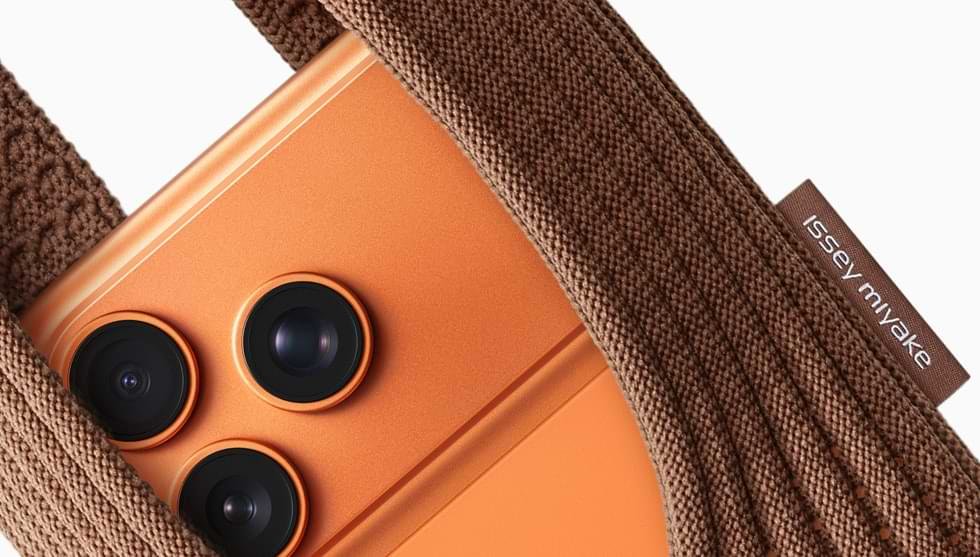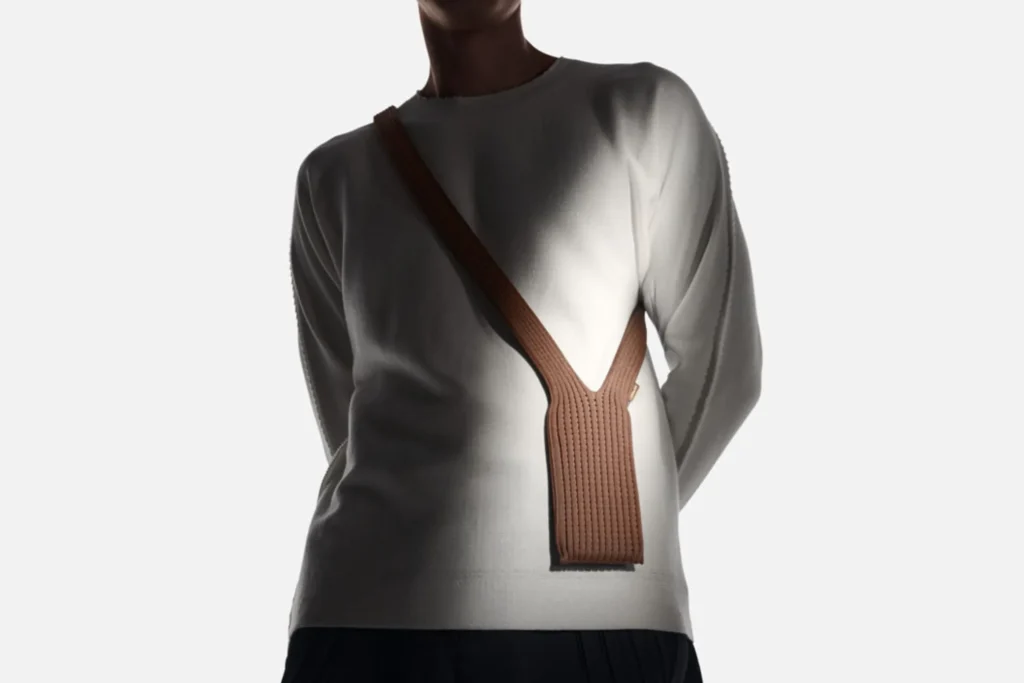iPhone Pocket
When Apple and Issey Miyake unveiled the iPhone Pocket on November 11, 2025, the tech giant sparked what might be its most polarizing product launch in years. At $230 for a 3D-knitted fabric pouch, the limited-edition accessory has become an instant cultural flashpoint, forcing a larger conversation about premium pricing, brand loyalty, and whether Apple’s luxury positioning strategy still holds water in 2026.
The backlash was swift. Marques Brownlee, one of tech’s most influential voices with over 19 million subscribers, called it “a litmus test for people who will buy/defend anything Apple releases.” Reddit threads exploded with disbelief. The comparison everyone couldn’t resist: in 2004, Steve Jobs sold six iPod Socks for $29 with a wink and a smile, acknowledging the product’s playful absurdity. Today, Apple asks $230 for what critics describe as essentially “a piece of cloth.”
But dismissing the iPhone Pocket as mere overpriced fabric misses the deeper strategic shift happening at Apple, and more importantly, what this product reveals about the company’s trajectory heading into 2026.
What Exactly Is the iPhone Pocket?
The iPhone Pocket represents a collaboration between Apple’s Design Studio and Issey Miyake’s design team, the same legendary Japanese fashion house that created Steve Jobs’ iconic black turtlenecks. Using singular 3D-knitted construction, the accessory features a ribbed open structure reminiscent of Miyake’s signature pleated designs.
The technical execution is admittedly impressive. The 3D knitting process creates a seamless, single-piece construction from continuous thread, eliminating cutting and waste while achieving an elastic structure that expands to hold an iPhone, AirPods, and other small items. When stretched, the mesh reveals glimpses of your iPhone’s display without requiring full removal.
Two versions hit select markets on November 14:
Short Strap Design: $149.95
Available in eight colors: lemon, mandarin, purple, pink, peacock, sapphire, cinnamon, and black
Long Strap Design: $229.95
Available in three colors: sapphire, cinnamon, and black
The accessory can be worn multiple ways: as a crossbody bag, wrapped around the wrist, or attached to other bags. Apple emphasizes that it fits any iPhone model dating back to the iPhone 8, plus all AirPods models. The color palette was deliberately designed to mix and match with Apple’s current iPhone lineup.
The Immediate Market Reaction: A Study in Contrast
The launch exposed a fascinating divide between different consumer segments and geographic markets.

The Critics: “Out of Your Damn Mind”
American consumers led the criticism charge. Social media erupted with variations of “said no one ever” when contemplating whether they needed an iPhone sock. The price point became the focal point of mockery, with users calculating that quality cotton costs roughly $20, knitting adds $10, meaning Apple’s brand premium represents roughly 90% markup.
Software engineer Andrew Yaros captured the business skepticism on LinkedIn: “I know Apple does things like this to position themselves as a luxury brand and as a shareholder, I still do not buy the idea stunts like these are what’s best for the company. At best, a small segment of the target demographic will see this as a curiosity at the cost of further damage to Apple’s reputation.”
TechSpot’s coverage emphasized the stark contrast with the iPod Socks’ playful humility versus the iPhone Pocket’s earnest luxury positioning. When Jobs introduced iPod Socks, he did so with humor, signaling Apple wasn’t taking the concept too seriously. The iPhone Pocket’s marketing contains no such self-awareness.
The Fashion Forward: “Season’s Must-Have”
But critics weren’t universal. Vogue declared the iPhone Pocket “could just be the season’s must-have accessory,” viewing it through a fashion lens rather than tech utility. This divide reveals crucial geographic and cultural factors shaping reception.
Apple strategically limited the launch to specific markets: US, UK, France, Greater China, Italy, Japan, Singapore, and South Korea. Even within these countries, physical availability is restricted to flagship stores in fashion capitals: Apple SoHo in New York, Apple Ginza in Tokyo, Apple Regent Street in London, Apple Piazza Liberty in Milan, and Apple Marché Saint-Germain in Paris.
Canadian technology journalist Jon Fingas articulated the cultural element: “Crossbody phone holders are hugely popular in places like China, Japan, and South Korea (hence the countries and retail stores involved). This isn’t about practicality, this is Apple getting into a fashion segment that could directly impact iPhone sales in the region.”
The Strategic Context: Apple’s Accessory Gambit
Understanding the iPhone Pocket requires examining Apple’s broader accessory strategy and its evolution under Tim Cook’s leadership.
The Premium Pricing Playbook
Apple’s premium pricing strategy has become a defining characteristic of the brand. In 2021, Apple captured nearly 45% of global smartphone profits despite holding only 17% market share. This extraordinary profit concentration demonstrates the power of premium positioning: Apple doesn’t compete on volume, it competes on value perception and margin optimization.
The company’s pricing philosophy centers on what CFO Luca Maestri calls “maximizing gross margin dollars.” This approach positions price as a quality signal. Research shows that Apple successfully reinforces perceptions of superior quality, creates exclusivity appeal, and attracts customers who associate higher prices with better products.
But accessories occupy a special place in this strategy. Items like dongles, Watch bands, and iPad keyboards carry high gross margins because they’re sold to customers already invested in the ecosystem. These buyers are personalizing their experience and demonstrate lower price sensitivity. Above Avalon’s analysis explains that positioning certain items as accessories allows Apple to keep entry-level product pricing relatively accessible while extracting premium margins from engaged users.
The Hermès Precedent
The iPhone Pocket isn’t Apple’s first fashion house collaboration. The partnership with Hermès on Apple Watch bands established precedent for luxury accessories commanding extraordinary price premiums. Hermès Apple Watch bands retail for $300 to $1,500, targeting customers who view tech products as fashion statements rather than mere functional tools.
However, the Hermès collaboration succeeded because it offered genuine luxury leather craftsmanship from one of fashion’s most prestigious houses. The materials, construction, and brand heritage justified premium pricing to the target demographic.
The Crossbody Strap Experiment
September 2025 saw Apple launch its first crossbody iPhone strap for $59, designed to attach to select iPhone cases. Bloomberg reported this had been “a priority of the company’s design team,” attributed to growing popularity of crossbody phone accessories in Asian and European markets.
The $59 strap met some criticism for requiring a compatible case (adding cost) but represented reasonable pricing for the category. The iPhone Pocket’s $230 long strap version costs nearly four times as much, prompting questions about value proposition even among fashion-conscious consumers.
The Profitability Paradox: Does This Actually Make Sense?
Here’s where the iPhone Pocket story gets genuinely interesting from a business strategy perspective. Apple’s gross margin on the accessory likely exceeds 85%. The material cost, even with premium 3D knitting in Japan, probably runs under $25. Design and development were shared with Miyake. Marketing leverages existing Apple retail infrastructure.
So why the controversy? Because margin optimization doesn’t equal strategic coherence.

The Risk-Reward Calculation
Apple generates approximately $394 billion in annual revenue. Accessories (excluding AirPods and Apple Watch) contribute roughly 3-4% of total revenue. Even if the iPhone Pocket sells 100,000 units at $200 average selling price, it represents $20 million, or 0.005% of Apple’s revenue.
The upside is negligible. The downside? Potential brand damage that could affect the company’s most valuable asset: its reputation for understanding customer needs and delivering products that “just work.”
Apple’s brand positioning strategy targets affluent customers who view technology purchases as lifestyle statements. The brand has transformed itself from a computer manufacturer into a comprehensive lifestyle technology company. But lifestyle brands are built on aspiration tempered with accessibility. Hermès bags at $10,000 feel aspirational. A fabric phone pouch at $230 feels disconnected.
The China Factor: Strategic or Shortsighted?
The most defensible rationale centers on China and Asian markets. iPhone positioning in China remains crucial as Apple faces intense competition from Xiaomi, Huawei, and Oppo. These local brands have captured significant market share by offering comparable technology at lower price points.
Crossbody phone carriers aren’t niche in China; they’re mainstream. Young urban professionals routinely wear phones in pouches or holders as both fashion statements and practical solutions in crowded cities. Apple entering this category with a premium offering makes some strategic sense.
But here’s the problem: Chinese consumers are price-conscious and brand-savvy. They can buy stylish crossbody phone pouches from local fashion brands for $15-30. Unless Apple can demonstrate 10x value through superior design, materials, or brand cachet, the pricing undercuts the value proposition even in receptive markets.
The Brand Erosion Risk
Apple’s premium pricing has historically worked because customers perceived clear value: superior design, seamless integration, longer device lifecycles, better resale value, and ecosystem benefits. Products like iPhone, MacBook, and AirPods justify premiums through genuine differentiation.
The iPhone Pocket lacks this clear value delta. Consumers see similar functionality available elsewhere for a fraction of the price. When premium pricing isn’t anchored in differentiated value, it risks appearing extractive rather than aspirational. This perception could damage Apple’s carefully cultivated brand equity.
The Deeper Strategic Questions for 2026
The iPhone Pocket controversy points to larger strategic challenges Apple faces heading into 2026.
The Innovation Plateau
Apple’s 2026 roadmap, as outlined by Bloomberg’s Mark Gurman, includes significant products: foldable iPhone, smart home displays, under-display camera technology for 2027’s iPhone, and previews of smart glasses. These represent genuine innovation that could justify Apple’s premium positioning.
But between major product launches, the company increasingly fills gaps with accessories that feel more like brand merchandising than problem-solving. When was the last time an Apple accessory solved a problem you didn’t know you had, rather than creating a solution to a problem Apple created (looking at you, dongles)?
The risk is that excessive focus on accessory revenue extraction while core products plateau could accelerate the perception that Apple’s best innovation years are behind it.
The Luxury Brand Tightrope
Apple successfully positions itself in the luxury market, with the iPhone dominating 78% of the $1,000+ smartphone segment and 57% of the overall $400+ device category. This positioning enables extraordinary margins and customer lifetime value.
But luxury brands maintain mystique through scarcity, craftsmanship, and exclusivity tied to genuine value. Hermès commands premium prices because of leather quality, artisan construction, and century-old heritage. Rolex justifies its pricing through precision engineering, materials, and brand prestige built over decades.
Apple’s attempts to position fabric accessories at luxury price points without corresponding craftsmanship or heritage risks diluting rather than enhancing its luxury positioning. There’s a fine line between aspirational premium and tone-deaf excess.
The Wearables Bet
One interpretation positions the iPhone Pocket as part of Apple’s broader wearables strategy. The company has successfully expanded beyond traditional computing into wearables through Apple Watch and AirPods. These products created entirely new revenue streams while deepening ecosystem lock-in.
The iPhone Pocket could represent experimental product thinking about wearable iPhone accessories beyond just cases. If crossbody phone carrying becomes mainstream globally, Apple wants presence in that category. The current execution may be flawed, but the strategic intent, testing wearable accessories in fashion-forward markets, makes sense.
However, for this strategy to succeed, Apple needs to nail product-market fit and pricing that encourages adoption rather than ridicule. At $230, the iPhone Pocket is positioned as statement piece for early adopters rather than category-defining product for mainstream users.
What the Numbers Tell Us: Market Response Analysis
Limited-edition launches make quantitative analysis challenging, but we can triangulate likely performance based on comparable products and early signals.

Comparable Product Performance
iPod Socks (2004-2012): Sold modestly throughout its run. Six-pack at $29 represented low-risk purchase for engaged iPod users. Product became more memorable for its whimsy than sales volume.
Apple Watch Hermès Edition (2015-present): Successful niche product among luxury watch buyers. Prices ranging from $1,249 to $1,899 find receptive audience because Hermès brings genuine luxury credentials and Apple Watch functionality justifies premium over traditional watches.
iPhone Leather Cases (ongoing): $59-79 products sell well because they’re priced reasonably for the quality, protect expensive devices, and allow personalization. These hit the sweet spot of justifiable premium pricing.
Apple Crossbody Strap (September 2025): $59 price point plus required case (~$50) creates $109 total investment. Early sales data isn’t public, but anecdotal reporting suggests modest adoption, primarily in Asian markets.
Projected iPhone Pocket Performance
Conservative estimates suggest 50,000-75,000 units across all markets would represent success for a limited-edition launch. At average selling price of $190, this generates $9.5-14.3 million revenue.
For context, Apple’s accessories category (excluding AirPods and Watch) generates approximately $12-15 billion annually. The iPhone Pocket would represent 0.1% of accessories revenue at the high end of projections.
Physical retail
placement is telling. Only select flagship stores in major fashion capitals carry inventory, suggesting Apple anticipated niche appeal rather than mass-market adoption. This aligns with luxury accessory strategy but questions whether the product merited the development and partnership resources invested.
The Secondary Market Test
One reliable indicator of product success is secondary market activity. Hermès Apple Watch bands maintain strong resale value, often selling for 70-80% of retail price years after purchase. This demonstrates genuine desirability beyond initial hype.
If iPhone Pockets begin appearing on secondary markets at significant discounts within months of launch, it signals failed value proposition. Early adopters who realize the product doesn’t justify its premium will attempt to recoup some investment, flooding resale channels and depressing prices.
Conversely, if limited supply creates secondary market premiums, it validates the fashion accessory positioning, even if critics disagree with the product concept.
The 2026 Outlook: Where Does Apple Go From Here?
The iPhone Pocket launch offers crucial lessons for Apple’s strategy heading into what Gurman calls “one of its most pivotal years in recent memory.”
Scenario 1: The Accessory Retreat
If iPhone Pocket sales disappoint and criticism intensifies, Apple quietly discontinues the product after limited initial run. The company takes a modest financial hit but larger brand perception hit. This could prompt reassessment of premium accessory strategy, leading to more conservative pricing and positioning for future accessories.
Probability: 40%
Impact: Limited short-term, but could signal shift away from aggressive accessory revenue extraction.
Scenario 2: The Niche Success
iPhone Pocket finds receptive audience in fashion-conscious Asian markets, particularly Japan and China. Sales volume is modest but margins are exceptional. Product achieves cult status among fashion-forward early adopters. Apple continues similar collaborations with fashion houses for limited-edition accessories targeting luxury market segment.
Probability: 35%
Impact: Validates luxury accessory strategy for specific markets, but doesn’t significantly move revenue needle.
Scenario 3: The Surprising Hit
Against skeptics’ expectations, iPhone Pocket becomes must-have accessory for 2026. Social media influencers embrace it, celebrities are photographed using it, and fashion magazines feature it in spreads. The “ridiculous overpriced phone sock” transforms into covetable status symbol. Apple expands the line and raises prices further.
Probability: 15%
Impact: Major vindication of luxury positioning strategy, encouraging bolder fashion experiments.
Scenario 4: The Strategic Pivot
Apple uses iPhone Pocket feedback to develop more accessible wearable phone accessories. Future iterations come in at $59-99 price points with clear functional benefits (security, convenience, storage). The company acknowledges market feedback and adapts, demonstrating flexibility rather than doubling down on luxury positioning.
Probability: 10%
Impact: Positive signal about company responsiveness to market needs rather than brand vanity.
The Broader Implications for Tech-Fashion Convergence
The iPhone Pocket sits at the intersection of three converging trends worth watching through 2026.
Wearable Technology Evolution
We’re transitioning from wearables that are distinct devices (watches, earbuds) to everyday items with embedded technology. Smart clothing, sensor-equipped accessories, and augmented reality glasses represent the next frontier.
Apple’s long-term smart glasses development and rumored AR initiatives position the company for this future. But the journey from iPhone Pocket to mainstream smart accessories requires careful product development that balances fashion, function, and pricing.
The phone pouch category specifically is interesting because phones have become so large that traditional pockets often don’t accommodate them comfortably. Particularly for women’s fashion, which notoriously lacks functional pockets, convenient phone-carrying solutions have genuine utility. Apple’s execution may be flawed, but the underlying problem space is real.
Luxury Tech Positioning Limits
There’s a ceiling to how far tech companies can push into pure luxury territory. Apple’s brand positioning succeeds because it delivers genuine technological value alongside luxury aesthetics. When the technology delta disappears and only aesthetic/brand premium remains, customers rebel.
Luxury fashion houses like Louis Vuitton, Gucci, and Prada successfully charge extraordinary prices for items with minimal functional differentiation (a $2,000 handbag vs. $50 equivalent) because fashion’s value proposition is explicitly about status, craftsmanship, and heritage, not utility.
Tech products carry implicit utility value propositions. An iPhone at $1,000 performs dramatically better than a $200 Android phone across multiple dimensions: camera quality, software optimization, ecosystem integration, security, longevity. This justifies the premium.
A $230 fabric phone pouch doesn’t perform dramatically better than a $20 equivalent. The gap is purely brand and design, which is harder to justify in tech consumer mindsets.

The Asian Market Opportunity
Apple’s growth trajectory increasingly depends on Asian market penetration, particularly China and India. Regional iPhone positioning varies significantly, with price sensitivity and competitive dynamics differing from Western markets.
Products like iPhone Pocket that directly address Asian market preferences (crossbody phone accessories) while carrying premium Apple branding could unlock new revenue streams. But pricing must reflect local market willingness to pay and competitive alternatives.
The challenge is that mass-market adoption in Asia requires accessibility, while luxury positioning demands exclusivity. Apple must decide whether it’s targeting the hundreds of millions of middle-class Asian consumers with aspirational but attainable products, or the small percentage of ultra-affluent luxury buyers.
Critical Analysis: Three Strategic Mistakes
Stripping away the noise, the iPhone Pocket reveals three strategic errors that offer lessons for product development in 2026.
Mistake 1: Solving the Wrong Problem
Apple excels when it identifies unmet needs and delivers elegant solutions. iPod solved portable music. iPhone revolutionized mobile computing. AirPods made wireless earbuds that actually worked. These products solved real problems customers experienced.
What problem does iPhone Pocket solve? The stated answer, “creating an additional pocket,” is
laughable when virtually everyone wearing pants has pockets. The unstated answer, making iPhone-carrying fashionable in crossbody form, addresses a niche need that existing products already solved at much lower price points.
Great products solve important problems for many people or solve narrow problems extraordinarily well. iPhone Pocket does neither.
Mistake 2: Ignoring Price-Value Perception
Psychological pricing matters enormously in consumer technology. Apple’s $999 iPhones feel justified because the device is central to users’ daily lives and delivers obvious value. People use iPhones multiple hours daily for years.
A $230 phone pouch will be used occasionally by most buyers. The usage-to-cost ratio feels imbalanced. Even fashion-conscious consumers who might pay $230 for designer accessories can compare the iPhone Pocket’s 3D-knitted fabric to designer scarves, pouches, and bags offering comparable or superior materials, construction, and styling.
The pricing needs to match not just production costs plus desired margin, but customer perception of value relative to alternatives and usage intensity.
Mistake 3: Misjudging Brand Extension Limits
Strong brands can extend into adjacent categories, but there are limits. Apple successfully extended from computers to music players to phones to watches to earbuds. Each extension involved genuine technological innovation and ecosystem integration.
Extending into fashion accessories without comparable innovation or integration requires different justification. The Issey Miyake partnership provides some fashion credibility, but not enough to overcome fundamental product limitations.
Brand extensions work when the brand’s core equity (Apple’s innovation, design, ecosystem) transfers meaningfully to the new category. A fashion accessory that’s merely expensive fabric with Apple logo relies on brand power alone, which is insufficient.
The Path Forward: What Apple Should Do Next
If Apple leadership is paying attention, here’s the strategic playbook for accessory development in 2026:
1. Reconnect Accessories to Ecosystem Value
The strongest Apple accessories integrate seamlessly with the ecosystem. AirPods, Apple Watch, and MagSafe accessories succeed because they enhance core products’ functionality while maintaining premium pricing.
Future accessory development should prioritize products that genuinely enhance the iPhone experience through technology, not just fashion. Example: a crossbody accessory with integrated wireless charging, Find My tracking, and secure storage would justify premium pricing through added functionality.
2. Implement Tiered Accessibility
Apple can maintain luxury positioning at the high end while offering accessible entry points. The iPhone lineup exemplifies this: iPhone SE at $429, standard iPhone at $799, Pro models at $999+. Different price tiers serve different customers while maintaining brand coherence.
Apply the same logic to accessories. Offer limited-edition fashion collaborations at luxury price points for enthusiasts while ensuring mainstream accessories remain reasonably priced. The iPhone Pocket could have worked as a $299 ultra-premium limited edition IF accompanied by $59 standard crossbody options for broader market.
3. Listen to Market Feedback
The immediate negative reaction to iPhone Pocket’s pricing should prompt reflection, not defensiveness. Apple’s historical strength included willingness to admit mistakes: Mobile Me relaunch, Apple Maps improvements, butterfly keyboard abandonment.
If sales data confirms iPhone Pocket missed the mark, acknowledge it internally and adjust course. Use the feedback to inform future accessory strategy rather than doubling down on luxury positioning that customers reject.
4. Prioritize Innovation Over Brand Extension
Apple’s reputation was built on innovation that improved people’s lives. Accessories should embody this principle. Ask not “what can we attach the Apple brand to?” but “what accessories would meaningfully improve customer experience with our products?”
The answer might be products customers don’t yet know they want, which requires innovation and vision. It’s definitely not slightly more expensive versions of products that already exist without clear differentiation.
Conclusion: A Teachable Moment for 2026
The iPhone Pocket won’t make or break Apple’s business. At most, it represents a minor miscalculation in an otherwise successful accessories strategy. But it’s worth scrutinizing because it reveals vulnerabilities in Apple’s approach as the company navigates 2026’s challenges.
Apple faces intense scrutiny around App Store policies, regulatory pressures globally, tariff risks, and most critically, the innovation imperative. As competitors narrow technical gaps in smartphones, tablets, and laptops, Apple must continually justify premium pricing through differentiated value.
Products like iPhone Pocket that rely primarily on brand power rather than genuine innovation risk eroding the foundation that supports Apple’s entire business model. If customers begin perceiving Apple as a company that charges luxury prices for ordinary products dressed in minimalist aesthetics, the brand loses its most valuable attribute: trust that high prices reflect high value.
The company that Steve Jobs built wasn’t afraid to charge premium prices, but it earned the right through products that worked better, felt better, and integrated better than anything else on the market. Tim Cook’s Apple has maintained this standard across major product categories. The challenge is extending the same principle to accessories, fashion collaborations, and brand extensions.
As we head into 2026, with foldable iPhones, smart home displays, and AR glasses on the horizon, Apple has opportunity to reestablish its innovation credentials. These products will succeed or fail based on whether they solve real problems in ways only Apple can, not whether they carry the Apple logo at Apple prices.
The iPhone Pocket at $230 will likely be remembered as a curious footnote in Apple’s accessory history, much like the iPod Socks before it. But unlike iPod Socks’ self-aware whimsy at $29, the iPhone Pocket’s earnest luxury positioning at 8x the price feels like a company that’s lost touch with what made it great: understanding what customers actually want and need, then delivering it better than anyone else.
That’s a more concerning signal than any single product failure.
FAQ: The iPhone Pocket
Is the iPhone Pocket worth buying at $230?
For most consumers, no. The iPhone Pocket represents premium pricing for a relatively simple fabric accessory without clear functional advantages over alternatives available at $20-50. However, value is subjective. Fashion-conscious buyers who appreciate Issey Miyake’s design aesthetic, want a limited-edition Apple collectible, or view the iPhone Pocket as a status symbol might find personal value that justifies the price.
The objective assessment: you’re paying primarily for the Apple and Issey Miyake brands rather than superior functionality or materials. If brand prestige alone provides sufficient value to you, and you have disposable income for fashion accessories, the purchase might make sense. For utility-focused buyers, numerous alternatives exist at much lower price points.
What makes the iPhone Pocket different from cheaper phone pouches?
The iPhone Pocket’s primary differentiators are design pedigree and construction method. The 3D-knitting process creates a seamless, single-piece construction that’s technically sophisticated, reducing waste and creating elegant ribbed texture. Issey Miyake’s design aesthetic brings fashion credibility and references the designer’s signature pleated style.
Material quality is presumably higher than budget alternatives, with careful attention to elastic properties, color consistency, and durability. The color palette was specifically designed to complement iPhone colors for aesthetic coordination.
However, these differences represent incremental improvements rather than categorical advantages. Cheaper alternatives can hold phones securely, come in various colors, and function comparably for most users. The question becomes whether design sophistication and brand prestige justify 5-10x price premium over functional equivalents.
Will the iPhone Pocket fit newer, larger iPhone models?
According to Apple’s specifications, yes. The 3D-knitted construction is designed to fit any iPhone model, including the largest Pro Max variants. The elastic material expands to accommodate different phone sizes while maintaining form when holding smaller devices.
The ribbed open structure allows users to see their iPhone display through the fabric without full removal, which works across iPhone sizes. This universal compatibility is actually one of the product’s strengths, as buyers don’t need to worry about whether their specific iPhone model fits.
The pocket can also hold AirPods cases and other small items alongside an iPhone, though obviously filling it with multiple items reduces visibility of the screen through the mesh.
Why is the iPhone Pocket only available in select countries?
Apple positioned the iPhone Pocket as a limited-edition fashion accessory targeting specific markets where crossbody phone accessories have strong cultural acceptance. Countries included in the launch (US, UK, France, China, Italy, Japan, Singapore, South Korea) represent major fashion capitals and markets where wearable phone accessories are more mainstream.
The restriction to flagship Apple Stores in cities like Tokyo, Paris, London, Milan, and New York reinforces the fashion-accessory positioning rather than tech-accessory positioning. These are locations where luxury shoppers congregate and where Apple wants to cultivate a fashion-forward brand image.
Market analysis suggests crossbody phone carriers are “hugely popular” in places like China, Japan, and South Korea, making geographic targeting strategic. The limited availability also creates artificial scarcity that can drive demand among collectors and fashion enthusiasts.
How does the iPhone Pocket compare to Apple’s earlier crossbody strap?
Apple launched a crossbody strap accessory in September 2025 at $59, designed to attach to select iPhone cases. The iPhone Pocket differs in several ways:
Independence: The Pocket holds the iPhone independently, while the strap requires a compatible case (~$50), bringing total investment to ~$109.
Functionality: The Pocket fully encloses the iPhone in stretchy fabric, while the strap attaches to a rigid case. The Pocket allows glimpsing the screen through mesh; the strap requires removing the phone from the case.
Design: The Pocket represents a fashion collaboration with Issey Miyake using 3D-knitted construction. The strap is standard Apple accessory design in silicone and fabric.
Positioning: The Pocket is marketed as limited-edition fashion accessory. The strap is positioned as practical convenience accessory.
Price: The Pocket’s long strap version ($230) costs over double the strap + case combination ($109).
Both serve similar use cases (hands-free phone carrying) but target different customer segments with different value propositions.
What is 3D knitting and why does it matter?
3D knitting is an advanced textile manufacturing technique where a continuous thread of material is fashioned into three-dimensional form through computer-controlled knitting machines. Unlike traditional flat knitting which is then cut and sewn into shape, 3D knitting creates seamless, complete objects from a single piece of material.
Benefits include:
Zero waste: No cutting means no scrap material
Seamless construction: No stitching or seams that could fail or irritate
Complex geometry: Can create three-dimensional shapes directly
Customization: Each piece can be programmed uniquely without additional cost
Sustainability: Reduced material waste and processing steps
For the iPhone Pocket specifically, 3D knitting enables the ribbed elastic structure that expands and contracts while maintaining structural integrity. It’s genuinely sophisticated manufacturing.
The question is whether manufacturing sophistication justifies the price when the end product’s functionality matches simpler construction methods. Technical excellence doesn’t automatically translate to user value.
How should I care for my iPhone Pocket?
Apple hasn’t released official care instructions, but based on the materials (likely nylon and polyester blend based on typical 3D-knitting materials) and structure:
Cleaning: Hand wash in cold water with mild detergent. Avoid machine washing which could distort the shape. Rinse thoroughly and air dry flat.
Storage: When not in use, store loosely without stretching to maintain elastic properties. Avoid prolonged sun exposure which can fade colors.
Usage: While the material is elastic, avoid over-stretching beyond normal phone-plus-essentials capacity. Repeated extreme stretching could fatigue the elastic fibers.
Durability: The open structure makes the Pocket vulnerable to snags. Be cautious around rough surfaces, jewelry, and anything with sharp edges that could catch the fibers.
The fabric construction means the iPhone Pocket requires more careful handling than rigid case alternatives. It’s more akin to caring for a delicate garment than a typical phone accessory.
Does the iPhone Pocket provide any protection for my iPhone?
No. The iPhone Pocket is not a protective case and provides minimal protection against drops, impacts, or scratches. The soft fabric construction offers essentially zero impact protection. If you drop your iPhone while it’s in the Pocket, damage is likely.
The Pocket does provide some scratch protection from keys or other items when carrying multiple things together, but this is minimal. The open mesh structure means dirt and debris can potentially contact your iPhone screen.
If protection is your priority, you need a proper case underneath your iPhone, then place the cased iPhone in the Pocket. This adds bulk but maintains protection. The Pocket is primarily a carrying/fashion accessory, not a protective one.
This is a significant functional limitation compared to traditional crossbody phone accessories that often include protective elements.
Will there be more color options or versions in the future?
Apple hasn’t announced plans for additional versions, and as a limited-edition product, expansion seems unlikely. However, if sales exceed expectations or cultural reception improves, Apple and Issey Miyake could theoretically release additional colorways or seasonal versions.
The pattern suggests Apple is testing market response before committing to the category more deeply. Strong sales and positive sentiment could lead to expanded offerings. Poor performance likely means this remains a one-off experiment.
Collectors interested in the iPhone Pocket may want to purchase during initial availability, as restocking limited-edition Apple products is rare. Conversely, if you’re price-sensitive, waiting could lead to discounts if initial sales disappoint, though availability would be limited.
How does this collaboration reflect Issey Miyake’s design philosophy?
The iPhone Pocket reflects several hallmarks of Issey Miyake’s design approach:
Pleating innovation: The ribbed structure evokes Miyake’s signature pleating techniques, which he pioneered and perfected over decades.
“A piece of cloth” concept: Miyake often worked with the philosophical idea of starting from a single piece of fabric and transforming it into functional form without cutting.
Technology meets tradition: Miyake embraced advanced manufacturing (3D knitting) while maintaining connection to textile craft heritage.
Function and movement: Miyake’s designs prioritized how garments move with the body and adapt to different uses.
Minimalist aesthetic: Clean lines, subtle textures, and emphasis on form over decoration characterize Miyake’s work.
Notably, Issey Miyake designed Steve Jobs’ iconic black turtlenecks, making this collaboration particularly resonant within Apple’s history. Jobs admired Miyake’s philosophy of design simplicity serving function, which aligned with Apple’s own principles.
The question is whether a $230 phone pouch adequately represents these sophisticated design principles, or whether the collaboration trades on Miyake’s name without achieving his standard of genuinely innovative functional design.
Why did Apple choose now to release this product?
The timing reflects several converging factors:
Holiday season: November launch positions the iPhone Pocket for holiday gift-giving, when consumers are more receptive to premium accessories and fashion items.
Asian market strategy: Apple faces increasing competition in China and other Asian markets. Launching products that specifically address Asian fashion trends (crossbody accessories) represents strategic market responsiveness.
Accessory revenue focus: As iPhone sales growth slows globally, Apple increasingly emphasizes services and accessories revenue. Premium accessories with high margins help maintain profitability.
Fashion calendar alignment: Launching in November allows the iPhone Pocket to be positioned in fashion media’s holiday/gift guides and potentially featured in Spring 2026 collections.
Post-iPhone 17 launch: Coming after September’s iPhone launch, the Pocket provides another touchpoint for marketing and retail traffic during historically strong sales periods.
The timing is strategic from a retail calendar perspective but potentially problematic from a market sentiment perspective, as releasing a controversial product during Apple’s most important sales quarter risks creating negative headlines that could overshadow positive iPhone 17 and holiday sales narratives.
What does the iPhone Pocket reveal about Apple’s future direction?
The iPhone Pocket signals several potentially significant strategic shifts:
Deeper fashion integration: Apple increasingly views itself as a lifestyle/fashion brand rather than purely technology company. Fashion house collaborations like Issey Miyake and earlier Hermès suggest ongoing movement in this direction.
Accessories as revenue drivers: With smartphone market maturing, Apple seeks higher-margin accessory revenue. The willingness to test premium-priced accessories indicates this will continue.
Segment-specific products: Rather than one-size-fits-all accessories, Apple may develop products targeting specific geographic or demographic segments (e.g., fashion-conscious Asian markets).
Limited-edition strategy: Creating artificial scarcity through limited editions generates urgency and maintains premium positioning. This could become more common across categories.
Wearables experimentation: The Phone Pocket sits between traditional accessory and wearable device. It may represent early experimentation with wearable iPhone concepts before more advanced AR glasses and smart clothing.
However, the market response also reveals risk: pushing too far into pure fashion without technological innovation could alienate core customers who value Apple for functionality and innovation rather than brand luxury alone. The company must carefully balance luxury positioning with delivering genuine value that justifies premium pricing.
The iPhone Pocket might represent the outer limit of how far Apple can push into fashion-first accessories before experiencing brand damage.





